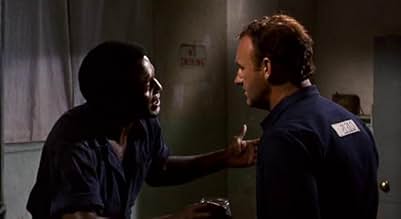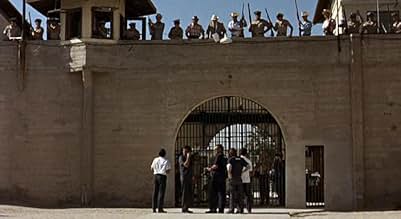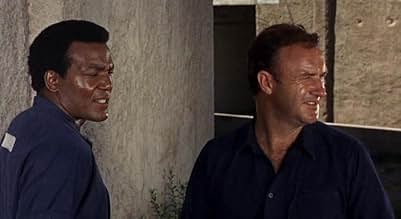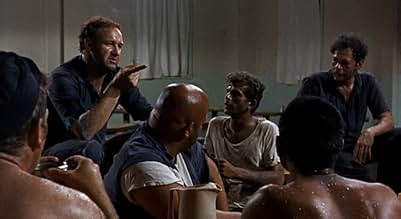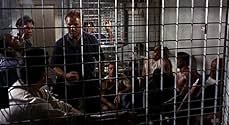AVALIAÇÃO DA IMDb
5,9/10
740
SUA AVALIAÇÃO
Uma rebelião em uma prisão estadual é encenada para encobrir uma tentativa de fuga, durante a qual muitos detentos e guardas são mortos. Filmado na Prisão Estadual do Arizona.Uma rebelião em uma prisão estadual é encenada para encobrir uma tentativa de fuga, durante a qual muitos detentos e guardas são mortos. Filmado na Prisão Estadual do Arizona.Uma rebelião em uma prisão estadual é encenada para encobrir uma tentativa de fuga, durante a qual muitos detentos e guardas são mortos. Filmado na Prisão Estadual do Arizona.
- Direção
- Roteiristas
- Artistas
- Direção
- Roteiristas
- Elenco e equipe completos
- Produção, bilheteria e muito mais no IMDbPro
Avaliações em destaque
I realized in time for his centenary tribute that this tense jailbreak thriller was produced by William Castle; the film does not have much of a reputation, however, and is perhaps most notable for being one of a number of transitory parts for Gene Hackman between his acquiring fame in BONNIE AND CLYDE (1967) and stardom via THE FRENCH CONNECTION (1971) – another such effort, THE SPLIT (1968), had partnered him with Jim Brown (who also assumes the leading role here). Indeed, Hackman's superiority in the acting stakes – despite essentially playing second- fiddle to ex-American Football luminary Brown – in comparison to the other participants (more on this later) is palpable throughout. Having said that, Gerald S. O'Loughlin is initially set out as the prisoners' chief nemesis but his contribution gradually diminishes once the titular event takes centre-stage.
The movie is basically an updated and more brutal version of earlier prison dramas, the obvious prototype being Don Siegel's noir classic RIOT IN CELL BLOCK 11 (1954). What is interesting in this case is that the riot is borne out of an attempted mass escape of the isolation division; when the latter is foiled, mastermind Hackman decides to buy some time – ostensibly negotiating system reforms with the authorities on the outside (as it happens, the fearsome warden has chosen this precise moment to take a break!) – while a tunnel is being laboriously dug from under the auditorium to freedom just past the walls of the vast compound!! Incidentally, Castle is to be commended for shooting this in an authentic Arizona correctional facility – with not only the real-life warden filling his respective shoes within the narrative (I wonder whether he was aware of how unsympathetically his office was being depicted!) but also a number of the convicts themselves!!
As I said, the film features a number of contemporary trappings which, frankly, do it (and even more so the genre involved) no more than a disservice – notably a substance-fuelled party by the inmates, with a handful of them in drag so as to titillate their 'colleagues'; one of them even invites coloured macho Brown to his cell, but he obviously backs off (preferring to envision a clutch of bikini-clad 'sisters' in the movie's one scene with female presences, drooling over him)! Similarly over-the-top are the actions of a wacky knife-happy Indian who constantly antagonizes Brown, and whom Hackman needs tagging along in order to supply guidance in their eventual flight to Mexico only to have his throat memorably slit by him at their very moment of glory (many of the intended fugitives had already been routed by the shrewd warden)! Among the assets, then, are the pristine DVD-sourced look and Krzysztof Komeda's unusual score (albeit backed by a recurring wistful ballad that acts as Brown's theme tune), the esteemed Polish composer's last effort prior to his untimely tragic death – and which ties the picture with Castle's much more distinguished production ROSEMARY'S BABY (1968).
The movie is basically an updated and more brutal version of earlier prison dramas, the obvious prototype being Don Siegel's noir classic RIOT IN CELL BLOCK 11 (1954). What is interesting in this case is that the riot is borne out of an attempted mass escape of the isolation division; when the latter is foiled, mastermind Hackman decides to buy some time – ostensibly negotiating system reforms with the authorities on the outside (as it happens, the fearsome warden has chosen this precise moment to take a break!) – while a tunnel is being laboriously dug from under the auditorium to freedom just past the walls of the vast compound!! Incidentally, Castle is to be commended for shooting this in an authentic Arizona correctional facility – with not only the real-life warden filling his respective shoes within the narrative (I wonder whether he was aware of how unsympathetically his office was being depicted!) but also a number of the convicts themselves!!
As I said, the film features a number of contemporary trappings which, frankly, do it (and even more so the genre involved) no more than a disservice – notably a substance-fuelled party by the inmates, with a handful of them in drag so as to titillate their 'colleagues'; one of them even invites coloured macho Brown to his cell, but he obviously backs off (preferring to envision a clutch of bikini-clad 'sisters' in the movie's one scene with female presences, drooling over him)! Similarly over-the-top are the actions of a wacky knife-happy Indian who constantly antagonizes Brown, and whom Hackman needs tagging along in order to supply guidance in their eventual flight to Mexico only to have his throat memorably slit by him at their very moment of glory (many of the intended fugitives had already been routed by the shrewd warden)! Among the assets, then, are the pristine DVD-sourced look and Krzysztof Komeda's unusual score (albeit backed by a recurring wistful ballad that acts as Brown's theme tune), the esteemed Polish composer's last effort prior to his untimely tragic death – and which ties the picture with Castle's much more distinguished production ROSEMARY'S BABY (1968).
"Riot" is a very tense film that was apparently based on a book about an actual prison situation that occurred in Minnesota. Oddly, however, "Riot" was filmed in Arizona--about the most un-Minnesota like place you can find! It's also unusual in that the famed horror director, William Castle, produced it.
The film stars Jim Brown and Gene Hackman, but they are not the entire show. In fact, while they clearly are the leads, the real stars are the many prisoners--many of which really were prisoners of the Yuma Correctional facility. It gets very high marks for realism that is missing from most other prison films and must have been seen as a VERY gritty film when it debuted. Flamboyantly gay prisoners, home brewed alcohol, impromptu courts to dispense 'justice' to snitches and a lot of blood are things you really don't see in other more sanitized prison films. Because of that, I highly recommend the film--it's tough, tense and exciting throughout.
The film stars Jim Brown and Gene Hackman, but they are not the entire show. In fact, while they clearly are the leads, the real stars are the many prisoners--many of which really were prisoners of the Yuma Correctional facility. It gets very high marks for realism that is missing from most other prison films and must have been seen as a VERY gritty film when it debuted. Flamboyantly gay prisoners, home brewed alcohol, impromptu courts to dispense 'justice' to snitches and a lot of blood are things you really don't see in other more sanitized prison films. Because of that, I highly recommend the film--it's tough, tense and exciting throughout.
Cool song "100 Years" sung by Bill Medley, music by Christopher Komeda. Shot on location at Arizona State Prison. Great performances by Jim Brown and Gene Hackman. A cool moment is the dream Cully Briston (Jim Brown) has when he takes a nap in the cell. The last 15 minutes of the film are also the best, the ones full of suspense. The rest of the movie is tense boredom.
"Riot" is a decent prison film, produced by William Castle (known as a director of things like "House on Haunted Hill") and directed by Buzz Kulik ('Brian's Song'). It stars Jim Brown, as cool as ever, as inmate Cully Briston, who realizes that the men of the isolation block have taken over that portion of the prison. Led by Red Fraker (Gene Hackman), they intend to pull off an escape, while pretending to the outside world to be petitioning for better conditions.
Ad copy may try to sell this as some kind of action film, but in truth it's more of a drama with some thriller elements. And it's NOT as violent as some people may fear, with some little bits of gore here and there. It doesn't attempt to show the lives of most of these inmates before their "riot". Cully has his misgivings about the whole thing, but gets caught up in it just the same, trying to talk some sense into Red.
The main asset of "Riot" is a degree of realism. It was based on a novel by Frank Elli, which was itself inspired by a real-life riot in a Minnesota prison. It features a number of inmates in supporting roles and bits, and even casts tough-as-nails real-life warden Frank Eyman to basically play himself. While it may not be truly action-packed, it has some great moments, especially the escape scenes near the end which are fraught with tension. The whole thing is professionally packaged, and nicely scored by Christopher Komeda.
Hackman is fun as the confident ringleader, while Brown remains highly watchable in his more even-keeled portrayal as a convict with some principles. Mike Kellin (who would return to the prison genre a decade later with "On the Yard"), Ben Carruthers (as the volatile, violent "Joe Surefoot"), and Clifford David (Beethoven in "Bill & Teds' Excellent Adventure") co-star as various inmates. Gerald S. O'Loughlin is good as a guard who's tried to dominate Cully for years, then turns weak after being used as a hostage.
"Riot" won't take a place as one of the great prison films, but it does entertain solidly for 97 minutes, which is all you can really ask for sometimes.
Seven out of 10.
Ad copy may try to sell this as some kind of action film, but in truth it's more of a drama with some thriller elements. And it's NOT as violent as some people may fear, with some little bits of gore here and there. It doesn't attempt to show the lives of most of these inmates before their "riot". Cully has his misgivings about the whole thing, but gets caught up in it just the same, trying to talk some sense into Red.
The main asset of "Riot" is a degree of realism. It was based on a novel by Frank Elli, which was itself inspired by a real-life riot in a Minnesota prison. It features a number of inmates in supporting roles and bits, and even casts tough-as-nails real-life warden Frank Eyman to basically play himself. While it may not be truly action-packed, it has some great moments, especially the escape scenes near the end which are fraught with tension. The whole thing is professionally packaged, and nicely scored by Christopher Komeda.
Hackman is fun as the confident ringleader, while Brown remains highly watchable in his more even-keeled portrayal as a convict with some principles. Mike Kellin (who would return to the prison genre a decade later with "On the Yard"), Ben Carruthers (as the volatile, violent "Joe Surefoot"), and Clifford David (Beethoven in "Bill & Teds' Excellent Adventure") co-star as various inmates. Gerald S. O'Loughlin is good as a guard who's tried to dominate Cully for years, then turns weak after being used as a hostage.
"Riot" won't take a place as one of the great prison films, but it does entertain solidly for 97 minutes, which is all you can really ask for sometimes.
Seven out of 10.
okay, here are what i don't think this movie and its screenplay are good enough: 1) never thought the black prisoners and the white ones could be so united in any prison history 2) the leader of the white prisoner, and the leader of the black ones seemed to respect each other quite well, they also cooperated with each other like brothers. the movie was released in 1969, and probably shot in the year before. do you think in that era and time frame, the blacks could have mixed with the whites so smoothly? they were used to be oil and water, they never could be mixed together, no matter what. 3) the black guy got a thick and high quality cow hide belt, and when he wanted to punch somebody, he just unbelted it from his waist and wrapped around his right fist. are you sure, dude? prisoners could have regular belts around his waists and never considered a dangerous weapon to other inmates and the prisons authorities? if shanks made in plastic or metal are considered deadly weapons, what about the belts? they could also be used as deadly weapons, don't you think? there are so many details that didn't feel all right but you can also let them go if you really need to watch a not quite exciting prison riot film but either a black prisoner's day dream or fantasy.
Você sabia?
- CuriosidadesArizona State Penitentiary warden Frank Eyman and 600 inmates and prison staff appear in the movie.
- Versões alternativasAn edited, "PG" rated version was released to theaters in 1970. Video version is the complete "R" rated version.
- ConexõesReferenced in Summer in the City (1971)
- Trilhas sonorasRAG MOP
Words and Music by Johnny Lee Wills and Deacon Anderson
Principais escolhas
Faça login para avaliar e ver a lista de recomendações personalizadas
- How long is Riot?Fornecido pela Alexa
Detalhes
- Tempo de duração
- 1 h 36 min(96 min)
- Mixagem de som
- Proporção
- 1.85 : 1
Contribua para esta página
Sugerir uma alteração ou adicionar conteúdo ausente

